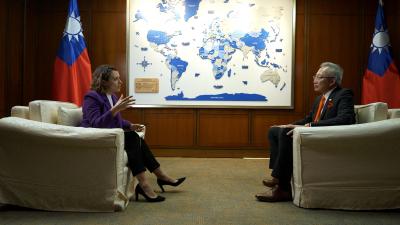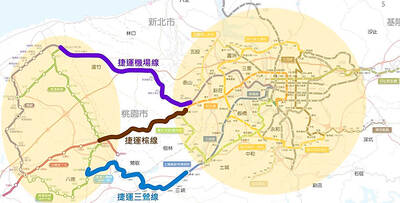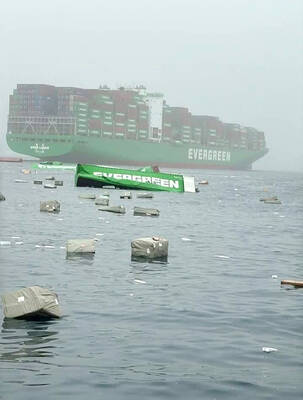While government officials called the agreement signed between the Straits Exchange Foundation (SEF) and the Association for Relations Across the Taiwan Strait (ARATS) on Nov. 4 as “a big step forward” in cross-strait trade relations, industry representatives said the results were not quite what they had expected.
Taiwan appeared to benefit in terms of cross-strait sea transport in the recent SEF-ARATS talks, they said. Once the agreement takes effect, vessels from Taiwan will be allowed to navigate directly to 63 Chinese sea and river ports.
Companies will also be exempt from paying business and income tax revenue derived from direct cross-strait shipping.
Under the terms of the agreement, vessels registered to shipping companies in Taiwan, Hong Kong and China can engage in direct cross-strait transport of passengers or cargo.
Flag-of-convenience (FOC) vessels, or those registered in another country, will also be allowed to participate in the direct shipping service, but will be restricted to those companies already engaged in offshore shipping center transport, cross-strait third-territory container line transport and the transportation of sand and gravel. The Ministry of Transportation and Communications (MOTC) said that the nation had 477 registered FOCs. The agreement only applies to 16 of them, or about 3 percent.
Meanwhile, qualifications outlined in the agreement essentially ruled out the nation’s bulk shipping carriers and FOCs operating with other countries. Some have even speculated that the measure is meant to encourage more shipping firms in Taiwan to switch their registrations to Hong Kong instead.
The government also sees the plans to increase cross-strait chartered flights as a breakthrough. The number of chartered flights will be increased from 36 per week to 108 per week, with each country allowed 54 flights. Services will also no longer be restricted to weekends.
But Tony Su (蘇宏義), chairman of the Taipei Airliners Association, said before the SEF-ARATS talks that the nation needed at least 84 weekly cross-strait charter flights if it aimed to have 3,000 Chinese tourists visit daily.
And though China now has 21 airports available for cross-strait charter flights service, Taiwan’s carriers are only planning to fly a few profitable routes — such as flights to Shanghai, which are capped at 20 per week.
The talks between SEF Chairman Chiang Pin-kung (江丙坤) and ARATS Chairman Chen Yunlin (陳雲林) also made it possible for both countries to launch anticipated chartered cargo flight services, starting with 60 flights per month.
However, what most of the nation’s carriers really wanted was to allow the passenger jets to carry freight, which is seen as a lucrative service. So far, both Taiwan and China have only agreed that passenger jets can carry airmail and packages sent by Chinese and Taiwanese postal services.
Representatives from the transportation and travel industries generally see resuming a dialogue between the two sides of the Strait as a positive development, though they do not necessarily agree with every detail of the negotiations.
China now “has all the bargaining chips,” they say. Whether it is about limitations on flights to big cities like Shanghai, the number of Chinese provinces from which residents are allowed to visit Taiwan, or the number of travel agencies authorized to organize group tours to Taiwan, they say China is in charge.
But they also have doubts about the ability of Mainland Affairs Council (MAC) officials to accurately represent them in the negotiations and defend their interests when discussing technical transportation issues.
Yao Ta-kuang (姚大光), chairman of the Travel Agent Association suggested that MAC officials could have used more leverage in the negotiations.
“Taiwan has allowed approximately 5 million Taiwanese to visit China since it lifted the restrictions two decades ago,” he said. “With the number of cross-strait charter flights that are currently available [36 flights], Chinese tourists who are able to come are only one-tenth the number of Taiwanese going to China. There’s no comparison.”
One travel service operator, who spoke on condition of anonymity, described the delegates from Taiwan as a “loosely formed team” and said they were dealing with experienced Chinese negotiators who participated in the first SEF-ARATS talk in 1993 in Singapore and subsequent talks in Shanghai in 1998.
Industry representatives were also upset at what they called the failure to include certain details in the cross-strait agreement.
Despite the downsides, MOTC officials said the agreement had drawn the attention of international sea liners and some have expressed an interest in registering their ships in Taiwan and setting up branches here.

“China is preparing to invade Taiwan,” Deputy Minister of Foreign Affairs Francois Wu (吳志中) said in an exclusive interview with British media channel Sky News for a special report titled, “Is Taiwan ready for a Chinese invasion?” the Ministry of Foreign Affairs said today in a statement. The 25-minute-long special report by Helen Ann-Smith released yesterday saw Sky News travel to Penghu, Taoyuan and Taipei to discuss the possibility of a Chinese invasion and how Taiwan is preparing for an attack. The film observed emergency response drills, interviewed baseball fans at the Taipei Dome on their views of US President

ECONOMIC BENEFITS: The imports from Belize would replace those from Honduras, whose shrimp exports have dropped 67 percent since cutting ties in 2023 Maintaining ties with Taiwan has economic benefits, Ministry of Foreign Affairs officials said yesterday, citing the approval of frozen whiteleg shrimp imports from Belize by the Food and Drug Administration (FDA) as an example. The FDA on Wednesday approved the tariff-free imports from Belize after the whiteleg shrimp passed the Systematic Inspection of Imported Food, which would continue to boost mutual trade, the ministry said. Taiwan’s annual consumption of whiteleg shrimps stands at 30,000 tonnes, far exceeding domestic production, the ministry said. Taiwan used to fill the gap by importing shrimps from Honduras, but purchases slumped after Tegucigalpa severed diplomatic ties with Taiwan

The Executive Yuan yesterday approved a southwestern extension of the Sanying MRT Line from New Taipei to Bade District (八德) in Taoyuan, with a goal of starting construction by late 2026. The 4.03-kilometer extension, featuring three new stations, will run from the current terminus at Yingtao Fude Station (LB12) in New Taipei City to Dannan Station (LB14), where it will connect with Taoyuan’s Green Line, New Taipei City Metro Corp said in a statement. This extension will follow the completion of core Sanying Line, a 14.29-kilometer medium-capacity system linking Tucheng (土城), Sansia (三峽)

CARGO LOSS: About 50 containers at the stern of the ‘Ever Lunar’ cargo ship went overboard, prompting the temporary closure of the port and disrupting operations Evergreen Marine Corp, Taiwan’s largest container shipper, yesterday said that all crew members aboard the Ever Lunar (長月) were safe after dozens of containers fell overboard off the coast of Peru the previous day. The incident occurred at 9:40am on Friday as the Ever Lunar was anchored and waiting to enter the Port of Callao when it suddenly experienced severe rolling, Evergreen said in a statement. The rolling, which caused the containers to fall, might have been caused by factors including a tsunami triggered by an earthquake in Russia, poor winter sea conditions in South America or a sudden influx of waves,